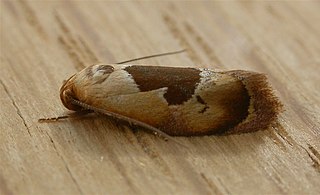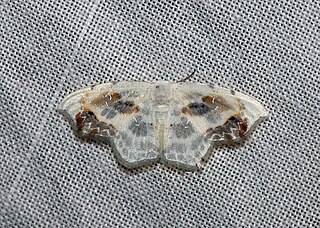
The Indian fritillary is a species of butterfly of the nymphalid or brush-footed family. It is usually found from south and southeast Asia to Australia.

Hoplomorpha camelaea is a moth in the family Oecophoridae first described by Edward Meyrick in 1888. It is found in Australia, where it has been recorded from Victoria, Queensland, New South Wales and the Australian Capital Territory.

Grammodes stolida, the geometrician, is a moth of the family Erebidae. The species was first described by Johan Christian Fabricius in 1775. It is found in Africa, southern Europe, most of Asia and Australia. It migrates to central and northern Europe as far north as England, Denmark and Finland.

Leucoblepsis renifera is a moth in the family Drepanidae. It was described by Warren in 1900. It is found on Peninsular Malaysia, Sumatra and Borneo.
Catacometes hemiscia is a moth in the family Oecophoridae. It was described by Edward Meyrick in 1883. It is found in Australia, where it has been recorded from New South Wales.
Ebbepterote is a monotypic moth genus in the family Eupterotidae. It was erected by Rolf G. Oberprieler, Wolfgang A. Nässig and Edward David Edwards in 2003. Its only species, Ebbepterote expansa, was described by Thomas Pennington Lucas in 1891. It is found in Australia, where it has been recorded from Queensland.
Stenoma eva is a moth of the family Depressariidae. It is found in Guyana.
Arignota stercorata is a moth in the family Xyloryctidae. It was described by Thomas Pennington Lucas in 1894. It is found in Australia, where it has been recorded from New South Wales and Queensland. It is also found in Papua New Guinea.
Illidgea epigramma is a moth in the family Xyloryctidae. It was described by Edward Meyrick in 1890. It is found in Australia, where it has been recorded from the Australian Capital Territory, New South Wales, Queensland and South Australia.
Lichenaula laniata is a moth in the family Xyloryctidae. It was described by Edward Meyrick in 1890. It is found in Australia, where it has been recorded from New South Wales and Queensland.

Lichenaula appropinquans is a moth in the family Xyloryctidae. It was described by Thomas Pennington Lucas in 1901. It is found in Australia, where it has been recorded from New South Wales and Queensland.
Lichenaula circumsignata is a moth in the family Xyloryctidae. It was described by Thomas Pennington Lucas in 1900. It is found in Australia, where it has been recorded from Queensland.
Lichenaula comparella is a moth in the family Xyloryctidae. It was described by Francis Walker in 1864. It is found in Australia, where it has been recorded from New South Wales and Queensland.
Telecrates desmochrysa is a moth in the family Xyloryctidae. It was described by Oswald Bertram Lower in 1896. It is found in Australia, where it has been recorded from South Australia.
Xylorycta emarginata is a moth in the family Xyloryctidae. It was described by Thomas Pennington Lucas in 1900. It is found in Australia, where it has been recorded from Queensland.
Lichenaula provisa is a moth in the family Xyloryctidae. It was described by Thomas Pennington Lucas in 1900. It is found in Australia, where it has been recorded from Queensland.
Agriophara curta is a moth in the family Depressariidae. It was described by Thomas Pennington Lucas in 1900. It is found in Australia, where it has been recorded from Queensland.
Agriophara velitata is a moth in the family Depressariidae. It was described by Thomas Pennington Lucas in 1900. It is found in Australia, where it has been recorded from Queensland.
Phylomictis decretoria is a moth in the family Depressariidae. It was described by Thomas Pennington Lucas in 1900. It is found in Australia, where it has been recorded from Queensland.
Imma lichneopa is a moth in the family Immidae. It was described by Oswald Bertram Lower in 1903. It is found in Australia, where it has been recorded from Queensland.




